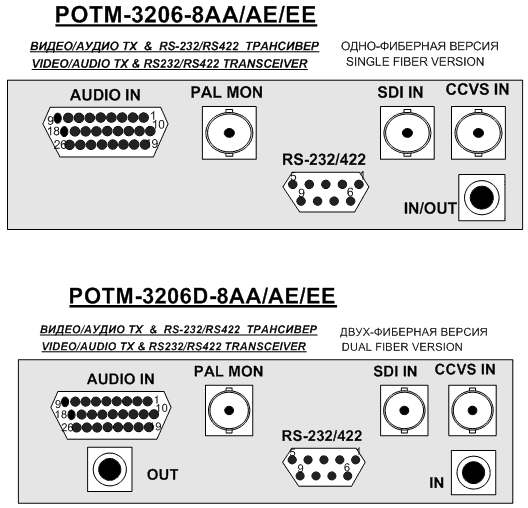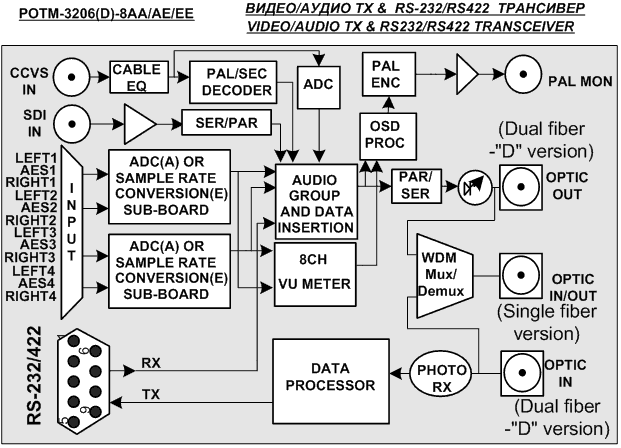|
|
Main / Optical interfaces / POTM-3206-8
| POTM-3206-8 multistandard PAL/SECAM/SDI video AND audio optical transmitters, RS-232/RS-422 data transceivers |
PROFLEX™ POTM-3206 multistandard PAL/SECAM/SDI optical transmitters accept up to eight audio channels and one RS-232/RS-422 data signal to provide the unidirectional audio-video and the bidirectional RS-232/RS-422 communication over a single-mode optical fiber. Either the single-fiber or the dual-fiber modification is available. The laser wavelengths:
- 1310±20nm and/or 1550±20nm in a single-signal or WDM optical system. In a single-signal system the 1550nm is optional, available by request
- 1270~1610nm with 20nm steps in a CWDM optical system (CW## model index: ## – the CWDM wavelength, for example - POTM-3206CW1550-AA).
The POTM-3206-8 module occupies two slots in the PROLFEX 1U/3U racks so that up to two transmitters fit into a 1U rack and up to eight into a 3U rack.
POTM-3206-8 transmitter is intended to pair with PORC-3226 series receivers which are WDM/CWDM/single-signal compatible.
The following transmission modes are available:
POTM-3206 (transmitting side modes) |
|
PORC-3226 (receiving side options) |
PAL/SECAM (undecoded)
Audio
RS-232/RS-422 |
=> |
OUT A/B: PAL/SECAM (standard as per transmitting side)
Audio
RS-232/RS-422 |
PAL/SECAM (decoded)
Audio
RS-232/RS-422 |
|
OUT A/B: PAL/SECAM/SDI (user-selectable)
Audio
RS-232/RS-422 |
OUT A: PAL/SECAM/SDI (user-selectable)
OUT B: always SDI
Audio
RS-232/RS-422 |
SDI
Audio
RS-232/RS-422 |
|
OUT A/B: PAL/SECAM/SDI (user-selectable)
Audio
RS-232/RS-422 |
OUT A: PAL/SECAM/SDI (user-selectable)
OUT B: always SDI
Audio
RS-232/RS-422 |
The video output signal standard is user-selectable.
The RS-232/RS-422 data transmission speed: up to 150 kBit/s.
The input and output audio signal may be in any standard: an analog, AES or combination of both. These modificatiuons are designated the following model indexes:
- eight analog balanced inputs (24-bits ADC): the "AA" index, (f.e. POTM-3206-8-AA)
- four analog balanced inputs and two balanced AES/EBU input (8 channels total): the "AE" index, (f.e. POTM-3206-8-AE)
- four balanced AES/EBU inputs (8 channels): the "EE" index, (f.e. POTM-3206-8-EE)
Both the transmitter (POTM-3206) and the intended receiver (PORC-3226) are featuring the PAL-monitor output with the OSD of the bar-graph audio level meters (quasi-peak and VU).

Depending on one's application demands the following hardware specifications are available:
Model |
No. of fibers |
TX optical power |
RX sensitivity |
Notes |
POTM-3206-8-AA/AE/EE
PORC-3226-8-AA/AE/EE |
1 |
-3dBm |
-18dBm |
1310nm/1550nm, WDM, unidirectional audio-video transmission, bidirectional data communication |
POTM-3206D-8-AA/AE/EE
PORC-3226D-8-AA/AE/EE |
2 |
0dBm |
-25dBm |
1310nm for both TX and RX |
POTM-3206CW##-8-AA/AE/EE
PORC-3226CW##-8-AA/AE/EE |
2 |
0dBm |
-25dBm |
Any CWDM wavelength for TX and RX with an external MUX/DEMUX ## - any of 16 available CWDM wavelengths |
POTM-3206 rear panel:

Features:
- multiformat inputs (SDI/PAL/SECAM)
- PAL/SECAM may be transmitted either decoded or "as is"
- analog inputs with high CMRR and overvoltage protection
- automatic cable equalizer on SDI input
- built-in 1kHz test generator
- built-in color bar generator
- signal loss indicator
- EDH status indicators
- automatic detection and indication of an embedded audio in an input SDI signal
- audio group selection for embedding;
- ancillary data stripping capability
- cascadability to allow for embedding of more than four audio groups
- high quality PAL/SECAM decoder
- bargraph audio level meter (quazi-peak and UV) OSD on PAL monitor output
- bidirectional RS-232/RS-422 support up to 150kbps
- compatibility with a single-signal, WDM and CWDM optical systems
- an analog, AES/EBU or combination of audio inputs
- 10-bits video ADC
- 24-bits audio ADC
General description
POTM-3206 simplified schematic diagram:

POTM-3206 accepts either analog composite video (PAL/SECAM) or digital (SDI) input signals. SDI input is equalized, decoded into a 10-bits 4:2:2 stream which is processed by a video/audio processor. An analog input is also equalized/normalized (EQ/GAIN) in a cable equalizer, decoded by a PAL/SECAM decoder and digitized into a 10-bits 4:2:2 stream. The PAL/SECAM decoder may be bypassed - in this case a special mark is inserted in the output stream by which a receiver automatically detects the transmission mode and the receiver's output format cannot be changed then.
The video/audio processor embedds the audio and RS-232/RS-422 data streams. Input audio may be an analog ("AA" model index), digital AES/EBU ("EE" model index) or combination of both formats ("AE" model index). The SDIembedded signal is present at the "SDI" output on a rear panel.
The dual-fiber modification exists that uses one fiber to send an audio-video-RS-232/RS-422 stream while the other fiber is used to receive the RS-232/RS-422 data. In a single-fiber modification the optical multiplexing on different wavelengths is used to separate optical signals in both directions (1310nm and 1550nm).
Technical specifications
- Input
- PAL/SECAM composite input
|
Input type |
AC-coupled, balanced, overvoltage protection |
|
Input impedance, connector type |
75 Ohm, BNC |
|
Cable equalization |
0...200m |
|
ADC |
10 bits at 27 MHz |
|
Frequency response ripple at 5,75 MHz (PAL/SECAM decoder bypassed) |
less than 0,2 dB |
|
LUMA channel frequency response (PAL/SECAM decoder is ON): |
|
SECAM |
2,0MHz |
3,0MHz |
3,9...4,7MHz |
5,8MHz |
|
± 0,2dB |
< -2dB |
> -40dB |
± 0,5dB |
|
PAL |
<0,5dB up to 5,8 MHz |
|
Return loss |
better than 40 dB at 4,43 MHz |
|
Differential phase |
less than 0,2 % |
|
Differential gain |
less than 0,2 % |
|
Signal to noise ratio |
> 65 dB |
|
Frame tilt |
< 0,5% |
|
2T overshoot |
less than 0,5% |
- SDI input
| Input impedance, connector |
75 Ohm, BNC |
| Automatic cable equalization |
up to 100m (8281or similar) |
- Analog AUDIO input
| Connector |
DB-15 |
| Input impedance |
10 kOhm |
| Input type |
balanced |
| 0 dB FS level |
+18dB (+24dB jumper-selectable) |
| Dynamic range |
better than 100dB |
| ADC |
24-bits at 48kHz (20 MSB are embedded) |
| Harmonic distortions and noise |
less than 0,006% |
- AES/EBU input
| Input type |
transformer balanced |
| Connector type |
DB-15 |
| Amplitude |
0.2~4.0V |
| Input impedance |
110 Ohm |
| Maximum input cable length |
up to 100 m of twisted pair |
- Optical input
| Number of inputs |
one |
| Photodiode |
InGaAs/InP PIN |
| Optical band |
1100~1650nm |
| Optical aperture |
120 µm |
| Optical connector |
FC/PC |
| Maximum optical input power |
0 dBm |
| Optical dynamic range |
-3~-25 dBm |
- Data input/output
| Connector |
DB -9F |
| Standard |
user-selectable RS-232/RS-422 |
| Max bitrate |
up to 150kbps |
- Output
- Optical output
| |
POTM-3206D-AA/AE/EE |
POTM-3206-AA/AE/EE |
POTM-3206DCW##-AA/AE/EE |
| Laser type |
FP |
FP |
DFB |
| Laser wavelength |
1310±20nm (1550±20nm by request) |
1310±20nm and 1550±20nm |
1270~1610nm with 20nm steps |
| Output optical power |
-3dBm |
-3dBm |
0dBm |
| Number of fibers |
two |
one |
two |
| Optical connector type |
FC/PC |
FC/PC |
FC/PC |
- PAL monitor output with OSD
| Connector type |
BNC |
| Amplitude |
1000±20mV at 75 Ohm |
| DAC |
10 bits |
| Frequency response |
<3dB to 5,5MHz |
POTM-3206 controls and indicators

The MODE button toggles through all the modes, the UP and DOWN buttons edit them.
- INP – input signal format selection and the built-in color bar generator ON/OFF, RS-232/RS-422 selection
- GROUP – the audio group selection for the embedding
- TON – the built-in 1kHz test tone generator ON/OFF
- METR – the VU-meter controls (ON/OFF, scale type, placement on the screen)
- ANC STRIP – ancillary data stripping ON/OFF
- AUD DET – lit when an input SDI has the embedde audio, blinks if the audio group number conflicts with the one detected in the input SDI
- EDH MIN/HOUR – lit if two or more EDH errors were detected within one hour/minute interval, both LEDs blink if an SDI input is lost
Configuring the POTM-3206 transmitter
The input signal format selection and the built-in color bar generator ON/OFF:
- Sd – SDI input signal
- CS – composite PAL/SECAM input transmitted WITHOUT decoding
- Cd – composite PAL/SECAM input transmitted being decoded (on a receiving side the output format is SDI/PAL/SECAM selectable).
- br – the built-in color bar generator is ON. An autonomous mode, no video input signal is nesessary, the audio embedding or 1kHz test signal are possible
RS-232/RS-422 data format selection:
Toggling the MODE button select the INP mode. Pressing the UP and DOWN buttons select the desired standard:
- 23 – data standard is RS-232
- 42 – data standard is RS-422
The audio group number selection:
Toggling the MODE button select the GROUP mode. Pressing the UP and DOWN buttons select an audio group number (Ø1, Ø2, Ø3 and Ø4 groups are available).ATTENTION! If there is an embedded audio in an input SDI, only the free group numbers will be available to select. For example, if SDIembedded input has the first group audio, only the Ø2, Ø3 and Ø4 could be toggled. It is advisable to select the nearest higher number, i.e. the Ø2 group. If we select a currently available group number and later the same group appears at the SDI input - the AUD DET indicator starts blinking notifying about the conflict. The POTM-3206 stops to embed it's audio and the input SDIembedded audio group is passed through. You should either select any other group or use the ANC STRIP mode to erase the input SDI from any preembedded audio data, the indicator will show the On mode, the conflict will be resolved and there will be no need to change the group number.
The 1kHz test tone operation:
- OF – the test signal is OFF in all channels
- On – the test signal is ON in all channels
- 01...04 – the test signal appears in a selected channel
Selecting the VU METR modes:
Toggling the MODE button select the METR mode. Pressing the UP and DOWN buttons adjust the horizontal position of the VU-meter OSD. Pressing the MODE and DOWN buttons simultaneously switches the OSD off (the indicator shows "On" -> "OF"). Pressing the MODE and UP buttons simultaneously selects the VU-meter scale mode:
- EBU scale, ØDBFS corresponds to +18 dBU (indicator shows "FS")
- quazi-analog scale, ØdBU corresponds to 0,775VRMS (indicator shows "db")
The ancillary data stripping:
In the case of a conflict between a selected audio group number and an input SDIembedded stream one may resolve it by stripping the input SDI signal. Toggling the MODE button select the ANC STRIP mode.Pressing the UP button enable the stripping mode. An indicator shows "OF" -> "On". Pressing the DOWN button disable the mode, the indicator shows "On" -> "OF".
Application examples
Dual fiber layout. The wavelength is 1310nm (1550nm by request) in both fibers:

CWDM layout. Any CWDM wavelengths for TX and RX, external optical MUX/DMUX:

Single fiber layout. WDM wavelengths (1310nm for TX, 1550nm for RX), built-in MUX/DMUX:

The remote control and management from a PC
All the “PROFLEX” modules are remote controllable from a PC. This facility is available if a rack is fitted with a CPU module (ordered separately). |